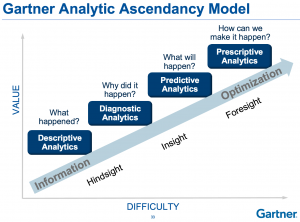
Data Driven Approach to Student Support
If you read any higher education blogs or news sites, you can’t get far without running into a story about the promise of analytics and big data. At Open SUNY, we are in the process of hiring an impact analyst to help us develop, measure, and analyze appropriate metrics. Data is clearly the “Next Big Thing,” but how we do get beyond the concept of data to the point where we are productively using the information available to us to better serve students?
One University that seems to be on their way to exploiting the potential of data is the University of Maryland University College (UMUC), a public online campus serving around 85,000 students around the world (UMUC has a close affiliation with the US Armed Forces, and many of its students are soldiers or their dependents). UMUC’s Beth Mulherrin and Thomas Porch recently presented at the UPCEA Summit for Online Leadership about what their campus is doing to use data to improve their student retention policies.
Mulherrin and Porch outlined UMUC’s (continued) evolution from siloed data that was simply historical in nature to real-time, integrated data that was predictive and ultimately prescriptive.

The campus is trying to collect data at ALL the critical milestones of a student’s experience at UMUC:
- When they make first contact expressing interest in UMUC.
- When they apply to UMUC.
- When they enroll in a course.
- When they complete a course.
- When they re-enroll for a course the following semester.
- When they graduate from UMUC.
UMUC has turned to a number of different sources for this data. They have developed their own internal metrics, and have turned outward to partner with the companies PAR and Civitas to help make sense of the information.
One technique they have incorporated is the use of “persistence scores”. Each student is assigned a persistence score, which is influenced by “hundreds” of variables. These persistence scores are updated daily and are monitored for low levels and dramatic changes. The campus is able to identify students at risk in real-time, hopefully before it is too late.
The creation of these persistence scores has not been without its questions on campus. UMUC does not know all the variables that make up these scores (they are developed by Civitas), nor do they know how these variables are weighted. They additionally had to provide access to all of UMUC’s LMS data and student data, which was not always a popular decision with faculty.
The availability of these persistence scores has allowed UMUC to judge the impact of various student support interventions in close to real time. While SUNY might have to wait until the end of a semester to see what impact an intervention might have on persistence, the persistence score allows you to judge the immediate impact on the likelihood of a positive outcome. This has allowed UMUC to take a very research-based approach to trying different interventions. Sending out targeted “mindset messages” at key points had a significant impact. Other interventions did not. The key is that they now have a quick, analytic way to determine the effectiveness of their efforts. The ultimate goal is to find the right treatment, at the right time, for the right student.
This type of large scale implementation takes a commitment of time and money. The potential payoff is a more efficient, more effective system to students supports that increases the success of everyone involved.